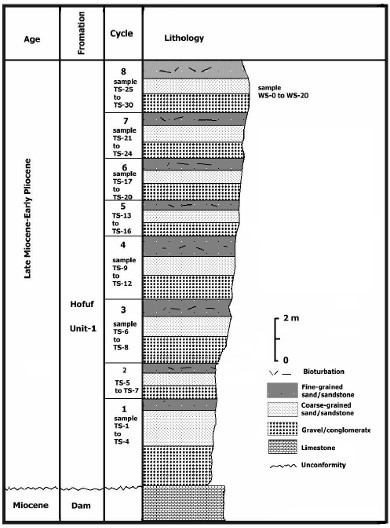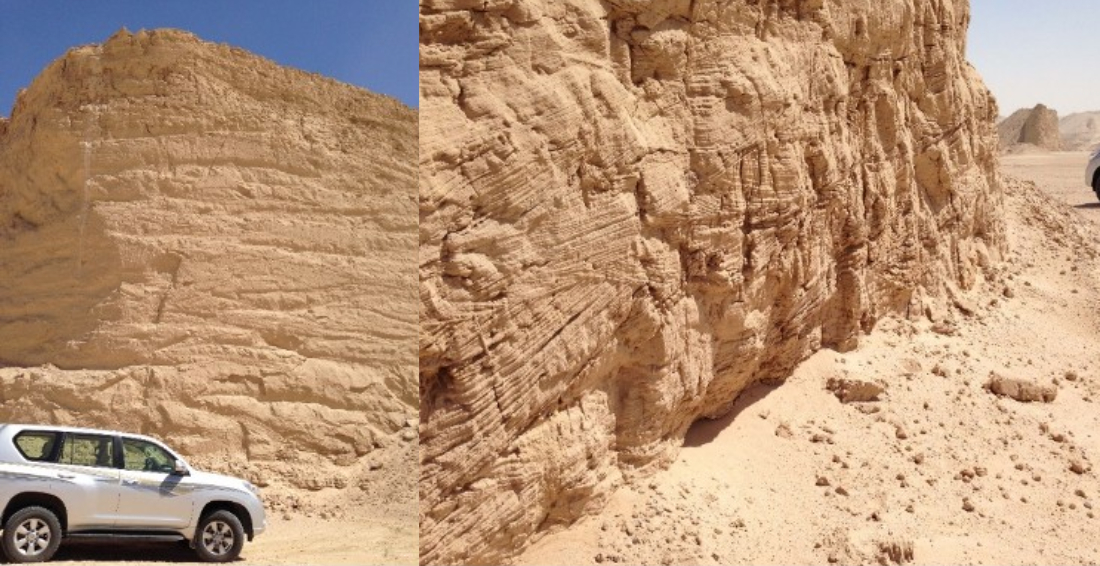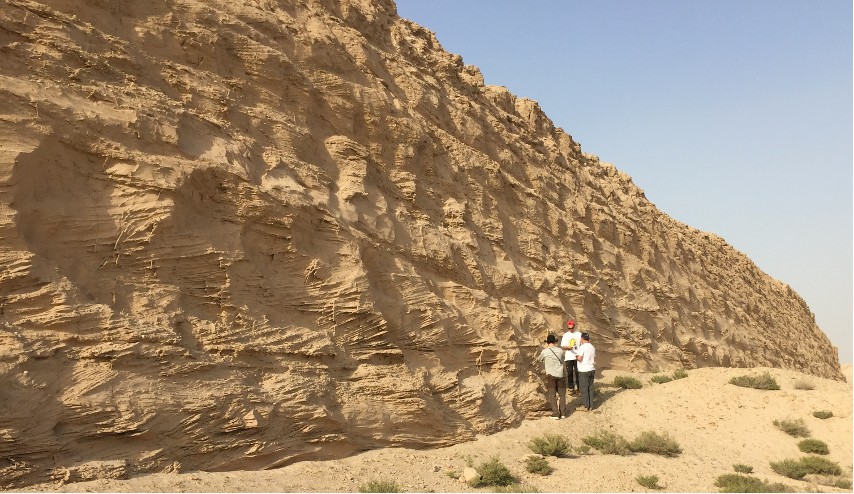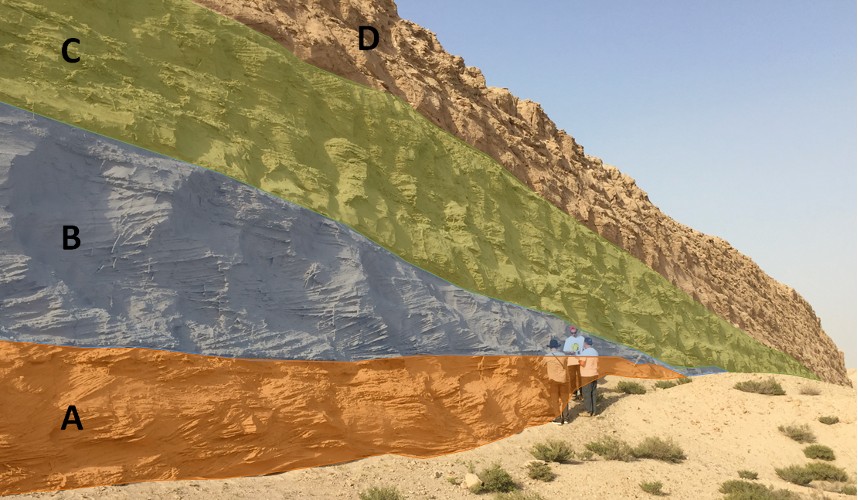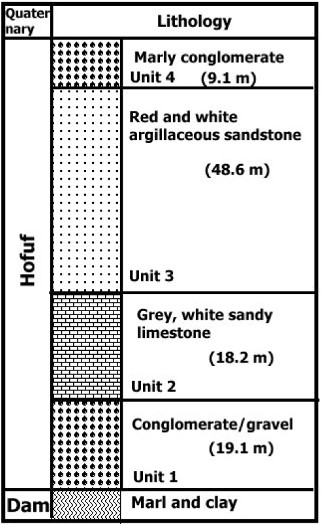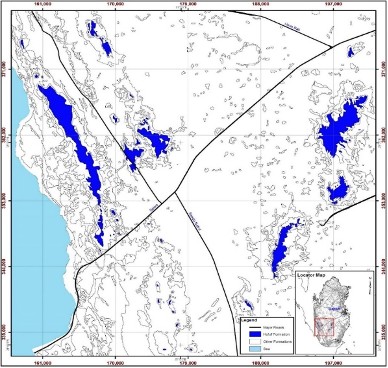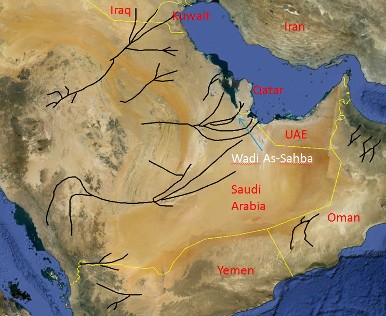Hofuf Fm
Type Locality and Naming
The Hofuf Formation is named after its type locality, some 17 km NNE of Al-Hofuf town in the Eastern Province of Saudi Arabia, at 25°31'30.0"N, 49°31'00"E (Fig. 1). It was first named by Steinecke M. and Koch T.W. in an unpublished 1935 report, Saudi Arabia) and used formally for the first time by Thralls and Hassan (1956). More detailed descriptions were made by Powers (1968) in Saudi Arabia; and Cavelier (1970a) in Qatar. Al-Sulaimi (1994); Al-Sulaimi and Mukhopadhyay (2000).
[Figure 1: Hofuf formation at the type section locality in Saudi Arabia. Al-Safarjalani (2004). Unit 1 is the only portion of the Hofuf present in Qatar.]
Synonym:
Reference Section:
In the Qatar National Cement Company (QNCC) quarry in Al-Subaiha/Wadi Al-Huweila area south of Umm Bab (Figs. 2, 3, 4, 5).
[Figure 2: Composite section of Unit 1 of the Hofuf formation in the Al-Subaiha/Wadi Al-Huweila area. After Al-Saad et al. (2002b)]
[Figure 3: Thickness of the sand & gravel Hofuf Formation in the QNCC’s quarry (left) and some cross-bedding of fluvial origin (right) (25°03’ 06”N, 50° 51’ 8.5”E); LeBlanc (2015a)]
[Figure 4: A 12m thick section of the Hofuf Formation in the QNCC quarry at locality 25°03'45.75"N and 50°49'53.33"E (see interpretation in Fig. 5)]
[Figure 5: Interpretation of features seen in Fig. 4 – D: Not interpreted; C: Channel abandonment formation (displaying soil/root remains) cross-cutting “B” (and “A” in the sub-surface). Compared to “B”, it displays less internal cross-beddings; B: Channel abandonment formation (displaying soil/root remains) cross-cutting “A” and displaying internal cross-beddings; A: Channel and sand bar formation with internal cross-beddings. (Its accurate thickness is unknown due to it being embedded under surface layer); Note: All the above concur with Al-Ansary et al (2012)’s interpretation of the Hofuf environment]
Lithology and Thickness
Sudgen et al. (1975) and Al-Safarjalani (2004): The main body is composed of sand, gravels and pebbles (quartz, jasper, crystalline rocks, limestone, etc.). The base usually consists of sandy red and green clay, and sometimes at the base of bulky sands and sandstones. Well-exposed, fine-grained to pebbly coarse-grained fluvial sandstone of Late Miocene to Pliocene age crops out in Southern Qatar (Fig. 81). These sandstones belong to the lower unit of the Hofuf Formation as exposed in Saudi Arabia and were deposited largely in paleostream channels along Wadi As-Sahba (Fig. 82) that extended into eastern Saudi Arabia and Qatar, a distance of over 450 kms. The upstream sediments were deposited in a deltaic environment. Wadi As-Sahba's alluvial fan, which extends southeastward, represents the largest of several other nonactive fans in central and south Arabia. It is the existence of this huge former drainage system, which is seen as the fundamental explanation for the occurrence of the Hofuf Formation in Saudi Arabia and comparable gravels elsewhere on the eastern flank of the Arabian Peninsula (e.g., Kuwait and Qatar). The sandstones are derived from the Precambrian basement and Phanerozoic rocks, and are mostly granitic rocks in addition to lesser amounts of volcanics, metamorphic and sedimentary rocks (granite, basalts, gneiss, schist, quartzite and amphibolites).
In the Al Subaiha/Wadi Al-Huweila area, the composite section has a thickness of 59.0 ft. (18 m) (Fig. 2) At least 8 sedimentary cycles are present. Each cycle is composed mainly of sandy conglomerate followed by coarse-grained sandstone and capped with bioturbated fine-grained sandstone. The thickness of these cycles’ ranges between 3.9 and 10.8 ft. (1.2 and 3.3 m). The main sedimentary structures observed in the different lithofacies are cross-beddings (Fig. 3). Biogenic features include bioturbation and soil/root remains. Three sedimentary facies can be recognized within the formation: clast-supported sandy conglomerate, coarse-grained sandstones, and fine-grained sandstones. Thickness ~14 m (~ 46 ft). The thickest sequence of Hofuf sediments present in Qatar is 14 meters of Unit 1 from the Al-Subaiha/Wadi Al-Huweila area; however, if a composite of few sections within this area is stacked together, the whole 18 metres of Unit 1 can be observed (Fig. 2)
TOP: ~ +70m (surface location at Subaiha/Wadi Al-Huweila, 25°03’ 06”N, 50° 51’ 8.5”E)
[Figure 6: Occurrence of the Hofuf Formation in Qatar.]
[Figure 7: The Hofuf Formation was deposited largely in paleostream channels along Wadi As-Sahba that extended into eastern Saudi Arabia and Qatar. Other such paleostreams also exist but do not reach into Qatar; instead, they divert into UAE, Kuwait or Iraq.]
Relationships and Distribution
Lower contact
Regionally, the schematic strat column indicates the next older unit as Dam Fm.
Upper contact
Regionally, the schematic strat column indicates this is the youngest unit.
Regional extent
It is equivalent to the Dibdibba Formation of Kuwait.
GeoJSON
Fossils
Very rare fragmented unidentified bivalve shells were observed (LeBlanc, unpublished, 2017). Other than those, it is safe to say that the Hofuf formation in Qatar lacks in any diagnostic fossil remains that would help in pinpointing the exact age of the deposits. In Saudi Arabia, only trace fossils of plant origin were ascertained in a reddish- and yellowish-brown horizon; Al-Safarjalani (2004).
Age
Depositional setting
Additional Information
Remark on the exploitation of the Hofuf sand: As explained by LeBlanc (2009), in certain areas the sand of the Hofuf Formation is contaminated by the presence of calcium carbonate (calcium, aragonite, etc), calcium sulphate (gypsum) and magnesium sulphates which negatively affect the quality of concrete and mortars that use this sand. This author demonstrated that mining the sand deposits of the Hofuf which directly overlay the Middle & Upper Al-Nakhash Members of the Miocene Dam Formation (from which most of these contaminants originate) will result in less economical exploitation. Al-Ansary et al. (2012) went one step further by stating that for the fluvial sand of the Hofuf it is recommended to mine from channel and sand bar layers and to avoid abandonment paleosol layers.
https://doi.org/10.37819/biosis.001.04.0134 (or via https://sites.google.com/site/leblancjacques)
